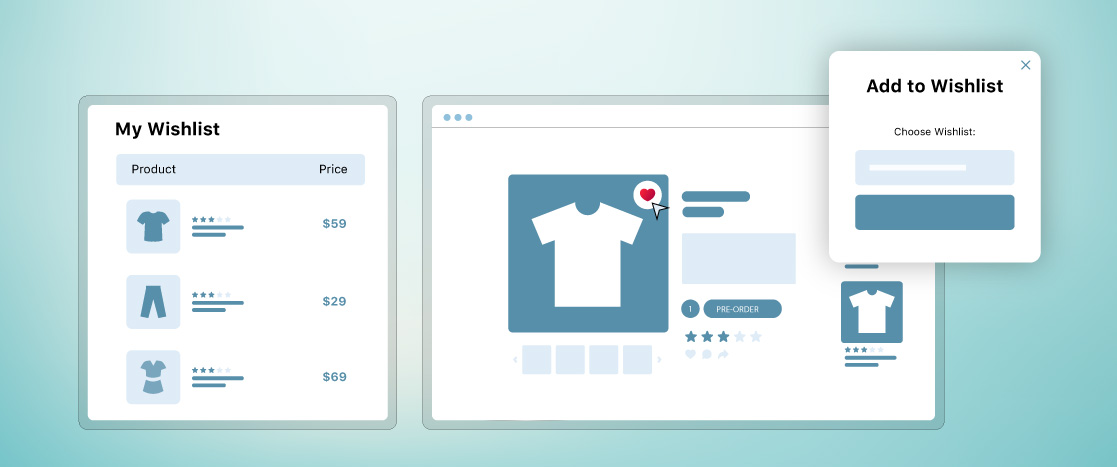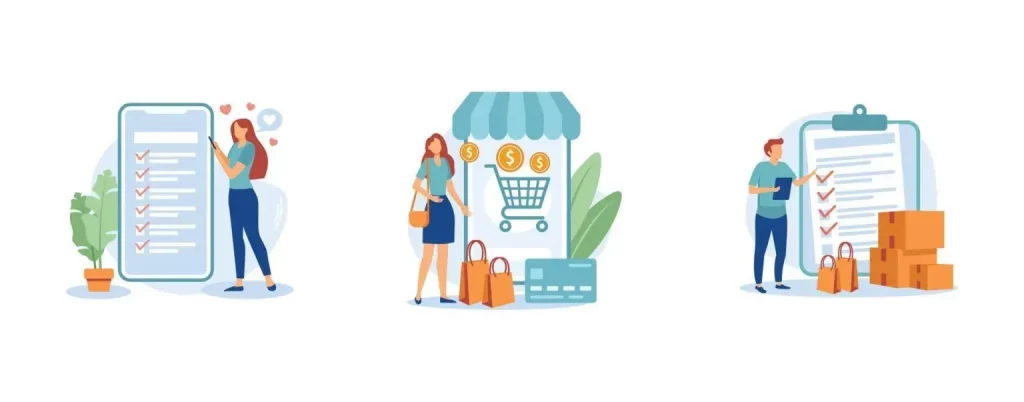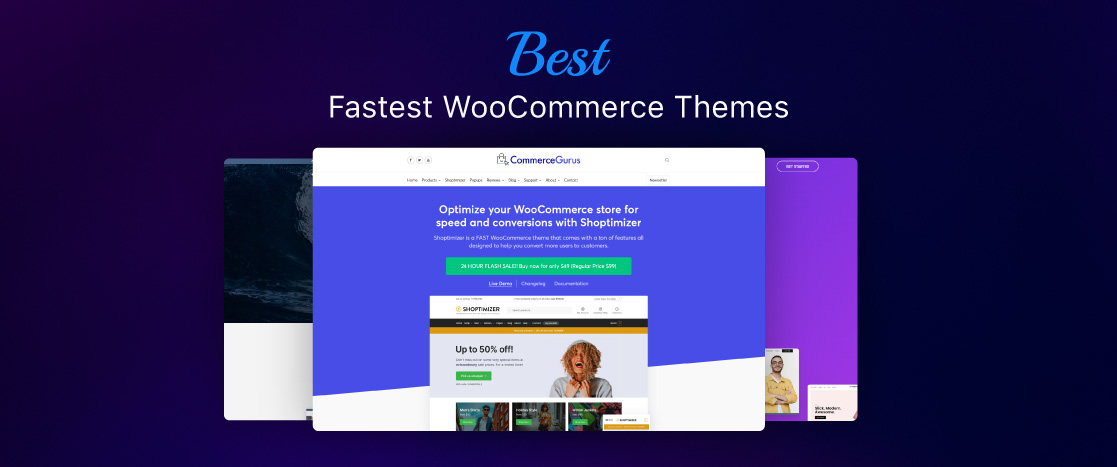
What is a WishList and Why It is an Important Feature in Ecommerce?
Wish lists are collections of products users have saved to their accounts to express interest in but not necessarily to buy.
Wish lists are useful for lowering shopping cart abandonment and completing transactions from customers who showed interest but ultimately decided not to buy. Wish lists enable retailers to evaluate product interest beyond a straightforward sale and provide customers with a convenient way to remind themselves about a product.
There are several types of wishlists that ecommerce platforms can offer:
- Public Wishlists: These are visible to anyone who has access to the link, allowing users to share their wishlist with friends and family, often for occasions like birthdays or holidays.
- Private Wishlists: These are only visible to the user who created them, offering a more personal and confidential way to save products.
- Shared Wishlists: These allow users to share their wishlists with specific individuals, often enabling collaboration in selecting gifts or planning purchases.

Why Wishlist is an Important Feature for a Website?
On an eCommerce website, the wishlist feature is an effective option for enhancing user experience and increasing sales. Customers can use it to save items they like but aren’t ready to buy immediately. This keeps the product at the forefront of consumers’ minds while easing the need to make a decision right away. Users return for reviews or purchase products from their stored list because of this convenience, which promotes repeat visits.
From an advertising perspective, wishlists provide useful information about consumer preferences, allowing for customized marketing tactics such as reminding customers or offering exclusive deals on wishlist products. Because users value being able to plan future purchases easily, they also help to increase customer loyalty. Additionally, reliable ecommerce hosting ensures seamless wishlist functionality, fast performance, and secure data storage, enhancing the overall shopping experience.
Additionally, since many platforms let users share their wishlists with friends and family, wishlists can improve social networking. This natural marketing strategy can raise brand awareness and draw in new clients.
Wishlists can be used by companies that prioritize inventory management to predict demand and improve stock planning. A wishlist is essentially an asset for enhancing engagement, comprehending client behavior, and eventually increasing conversions, in addition to being a convenience for customers. Long-term company growth and the general purchasing experience can both be greatly enhanced by adding this capability.
E-Commerce Wishlist Best Practices
Adding a wishlist function to your e-commerce platform can greatly increase customer engagement and conversions, but in order to get the most out of it, you have to follow to best practices. Make sure the wishlist is simple to use and easy to use first.
Simple Access with a User-Friendly Interface
Make sure the wishlist function is simple to use and displayed on product pages so that buyers can add products with just one click.
Option for a Guest Wishlist
To lower barriers and improve user experience, let users make and keep wishlists without requiring the establishment of an account.
Options for Personalization
Give consumers the option to add names or categories to their wishlists to help them stay organized and personalize them.
Features for Social Sharing
To boost engagement and spontaneous brand reach, include sharing options that allow users to share their wishlists with friends and family.
Automated Alerts
To stimulate purchases, send wishlist item alerts when prices decrease, inventory levels are low, or sales are happening.

The Psychology Behind Wishlists
Understanding the psychology behind wishlists is crucial for maximizing their potential. Wishlists cater to several psychological factors that influence consumer behavior:
- Delayed Gratification: Wishlists allow users to delay their purchases without losing track of the items they desire. This plays into the psychology of delayed gratification, where the anticipation of purchasing an item increases the perceived value of the product.
- Decision-Making Ease: By saving items to a wishlist, users reduce the cognitive load associated with making purchasing decisions. This leads to a more satisfying shopping experience as users can take their time to decide without the pressure of an immediate purchase.
- Sense of Ownership: Adding items to a wishlist gives users a sense of ownership over those products, even before making a purchase. This emotional connection can increase the likelihood of a future purchase.
By tapping into these psychological factors, ecommerce platforms can use wishlists to influence purchasing behavior and drive revenue growth.
Benefits of Integrating a Wishlist Feature
Adding a wishlist feature has several advantages, such as better conversion rates, increased customer retention, and an improved user experience. Users can keep their favorite products on wishlists, facilitating future purchases. In the end, they increase sales and brand loyalty by offering insightful information about consumer preferences, facilitating targeted marketing, and fostering organic growth through social sharing.
Increase in Conversion Rates
One of the key advantages of adding a wishlist function is the possibility for higher conversion rates. Wishlists drive consumers to return to the website, revisit the products they’ve saved, and finally make purchases. This function is extremely useful for clients who are not ready to buy right away but intend to return later.
For example, Moovweb discovered that ecommerce websites with wishlist options had a 30% higher conversion rate than those without. The capacity to save products for future consideration lessens the urgency of making a purchase decision, resulting in more careful and methodical purchasing behavior.
Enhancing Customer Experience
Wishlists significantly enhance the customer experience by allowing users to organize their shopping preferences. By offering a wishlist, ecommerce platforms provide customers with a convenient way to manage their shopping journey. This leads to a more personalized and user-friendly experience, which is crucial for customer satisfaction.
In addition to improving the shopping experience, wishlists also play a role in personalized marketing. Ecommerce platforms can use wishlist data to tailor marketing efforts, sending targeted emails and notifications about price drops, stock availability, or special promotions related to wishlist items. This level of personalization fosters a stronger connection between the brand and the customer, ultimately driving higher engagement and sales.
Boosting Customer Retention and Loyalty
Wish Lists are powerful tools for boosting customer retention and loyalty. By offering a feature that encourages users to return to the platform, ecommerce businesses can keep customers engaged over time. Repeat customers are more valuable than new ones, and wishlists are an effective way to nurture this relationship.
Moreover, wishlists can help reduce cart abandonment by giving users an alternative way to save products without adding them to the cart. This reduces the pressure to purchase immediately and keeps the user engaged with the platform. Over time, as customers revisit their wishlists and make purchases, they are more likely to develop brand loyalty and become repeat buyers.
Driving Sales with Wishlist Features
Using customer-curated lists to increase engagement and conversions is known as “Driving Sales with Wishlist Features.” Wishlists facilitate future buying, promote return visits, and allow for targeted marketing through alerts and promotions. Businesses can successfully convert interest into revenue and raise customer satisfaction levels by knowing consumer preferences and designing individualized experiences.
Targeted Email Marketing Campaigns
Wishlist data provides valuable insights for targeted email marketing campaigns. By analyzing the products in users’ wishlists, ecommerce platforms can send personalized emails that resonate with individual preferences. Examples of successful email campaigns include:
- Wishlist Reminders: Sending emails to remind users of items in their wishlist that they haven’t purchased yet.
- Price Drop Alerts: Notifying users when the price of a wishlist item has dropped.
- Stock Availability Updates: Informing users when a previously out-of-stock item in their Wishlist is back in stock.
These targeted campaigns can significantly boost conversion rates by tapping into the user’s interest in specific products.
Cross-Selling and Upselling Opportunities
Wishlists provide excellent opportunities for cross-selling and upselling. By analyzing the items in a user’s wishlist, ecommerce platforms can suggest complementary products or higher-end alternatives. For example, if a user has added a smartphone to their wishlist, the platform could recommend accessories like cases or headphones.
Upselling can also be effective when users are considering a lower-priced item. By highlighting a premium version of the product in their wishlist, ecommerce platforms can encourage users to spend more, thereby increasing the average order value.
Seasonal and Promotional Campaigns
Seasonal and promotional campaigns can be enhanced by leveraging wishlist data. During peak shopping seasons like holidays or Black Friday, ecommerce platforms can offer special discounts or incentives for wishlist items. For example, offering a limited-time discount on a user’s wishlist items can create a sense of urgency and encourage immediate purchases.
Promotional campaigns can also include bundle deals or free shipping offers on wishlist items, further incentivizing users to complete their purchases. By aligning wishlist features with seasonal promotions, ecommerce platforms can drive significant revenue growth.
Tracking Wishlists to Understand Customer Preferences
In the realm of ecommerce, understanding customer preferences is key to driving engagement and boosting sales. One of the most effective ways to gain this insight is by tracking the content of your customers’ wishlists. Wishlists are more than just a convenient feature for shoppers—they are a goldmine of data that can be leveraged to refine marketing strategies, enhance customer experience, and ultimately, increase revenue. By closely monitoring wishlist content, ecommerce businesses can gain valuable insights into customer behavior, preferences, and purchasing intentions.
Have Insight into Your Customers’ Wishlists
Gaining a deep understanding of what’s on your customers’ wishlists provides a unique window into their shopping habits and preferences. By analyzing wishlist content, you can identify trends in customer interest, such as popular products, preferred brands, and seasonal demand. This data is invaluable for tailoring marketing efforts, predicting future sales, and making informed decisions about inventory management.
Moreover, insight into customer wishlists helps you understand the different stages of the buyer journey. For instance, customers who frequently add items to their wishlist without completing the purchase may need additional incentives, such as special offers or personalized emails, to convert their interest into a sale. By using wishlist data strategically, you can engage customers more effectively and drive higher conversion rates.
View Product Count in Wishlists
Tracking the number of products included in a specific wishlist provides further insights into customer behavior. The size of a wishlist can reveal a lot about a customer’s shopping habits. For instance, a large wishlist with numerous items might indicate a highly engaged customer who is actively exploring various products but is undecided about making a purchase. On the other hand, a wishlist with only a few items could suggest a more focused shopper who is closer to making a buying decision.
Additionally, the number of products in a wishlist can help you gauge overall customer engagement with your platform. A high average number of wishlist items across your customer base might suggest that users are finding your product offerings appealing, whereas a low number could indicate a need to improve product variety or discovery features on your site.
Find Out When Each Wishlist Was Created
The creation date of a wishlist is another crucial piece of data that can inform your marketing and engagement strategies. Knowing when a wishlist was created allows you to track how long customers have been considering certain products and provides a timeline for their decision-making process.
On the other hand, if a wishlist was recently created, the customer may still be in the early stages of their decision-making process. You can use this information to nurture their interest with targeted content, such as product reviews, detailed descriptions, or comparisons that help them make an informed decision.
Track the Last Promotional Email Sent to Wishlist Users
Integrating wishlist tracking with your email marketing system enables you to easily figure out when each wishlist holder has received their last promotional email. This information is vital for maintaining a balanced and effective communication strategy with your customers.
By knowing the last time a customer received a promotional email, you can avoid overwhelming them with too many messages, which could lead to unsubscribes or reduced engagement. Instead, you can strategically time your emails to coincide with key moments in the customer’s shopping journey. For instance, if a customer has not interacted with their wishlist for a while, a well-timed email reminding them of their saved items, along with a personalized offer, could reignite their interest.
Conclusion
To summarize, the online store wishlist feature is a strong tool for improving customer experience, increasing conversion rates, and driving revenue growth. Wishlists make shopping more personal and fun by allowing consumers to save and categorize things that interest them.
Adding a wishlist option to an ecommerce website is a powerful method for optimizing it. Businesses may increase the impact of wishlists on sales and consumer engagement by adhering to best practices in design, customisation, and marketing.
If you run an ecommerce business, this is the perfect moment to consider adding a wishlist option to your website. By doing so, you will not only improve your clients’ buying experience but also drive considerable revenue growth for your company. Begin today and witness the impact a well-implemented wishlist feature can have!
FAQs
What is the difference between a shopping cart and a wishlist?
You can access your Wishlist by going to the My Account page. A link to share your wishlist with loved ones can then be obtained. Anyone having items in the shopping cart can use Saved Carts since they don’t require a Detailed Image account.
What’s the point of a wish list?
Wish lists assist consumers in remembering things they intend to purchase in the future. Wish lists give consumers more time to think things through before making a purchase, which can help them make better choices.





